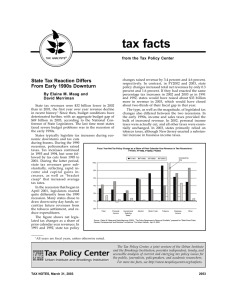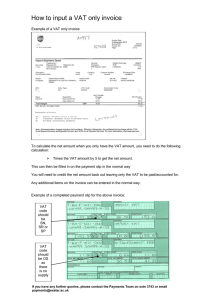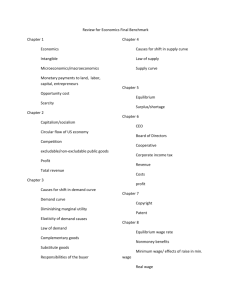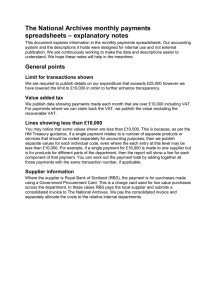ORGANIZATIONAL DEVELOPMENT
advertisement
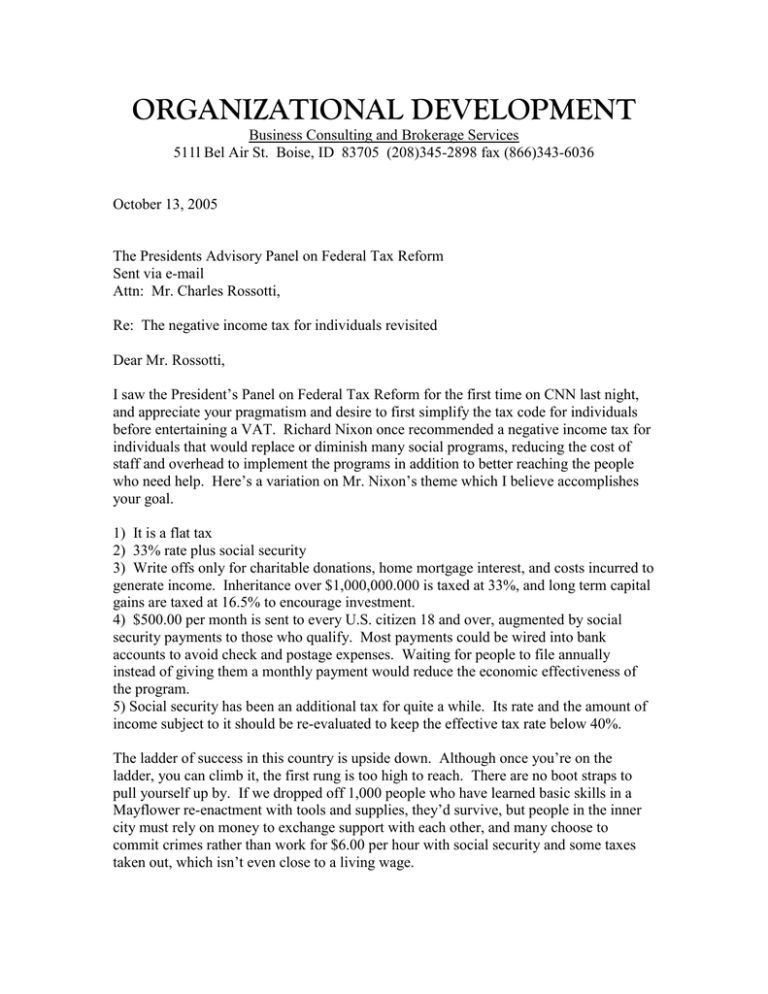
ORGANIZATIONAL DEVELOPMENT Business Consulting and Brokerage Services 511l Bel Air St. Boise, ID 83705 (208)345-2898 fax (866)343-6036 October 13, 2005 The Presidents Advisory Panel on Federal Tax Reform Sent via e-mail Attn: Mr. Charles Rossotti, Re: The negative income tax for individuals revisited Dear Mr. Rossotti, I saw the President’s Panel on Federal Tax Reform for the first time on CNN last night, and appreciate your pragmatism and desire to first simplify the tax code for individuals before entertaining a VAT. Richard Nixon once recommended a negative income tax for individuals that would replace or diminish many social programs, reducing the cost of staff and overhead to implement the programs in addition to better reaching the people who need help. Here’s a variation on Mr. Nixon’s theme which I believe accomplishes your goal. 1) It is a flat tax 2) 33% rate plus social security 3) Write offs only for charitable donations, home mortgage interest, and costs incurred to generate income. Inheritance over $1,000,000.000 is taxed at 33%, and long term capital gains are taxed at 16.5% to encourage investment. 4) $500.00 per month is sent to every U.S. citizen 18 and over, augmented by social security payments to those who qualify. Most payments could be wired into bank accounts to avoid check and postage expenses. Waiting for people to file annually instead of giving them a monthly payment would reduce the economic effectiveness of the program. 5) Social security has been an additional tax for quite a while. Its rate and the amount of income subject to it should be re-evaluated to keep the effective tax rate below 40%. The ladder of success in this country is upside down. Although once you’re on the ladder, you can climb it, the first rung is too high to reach. There are no boot straps to pull yourself up by. If we dropped off 1,000 people who have learned basic skills in a Mayflower re-enactment with tools and supplies, they’d survive, but people in the inner city must rely on money to exchange support with each other, and many choose to commit crimes rather than work for $6.00 per hour with social security and some taxes taken out, which isn’t even close to a living wage. 2 Unlike the aid to dependent children which was dysfunctional, this program encourages marriage. A homeless couple can share a two bedroom apartment with a roommate, and all can afford food, a phone and clothes at the thrift store and bus fare to be able to contact employers and be presentable in the work place. Once their base needs can be met by partnering with a friend, there is an incentive to generate additional income to improve their standard of life. This effect was seen in Seattle when free shelter was proved to the homeless near the Pike Place Market. Getting people back to work obviously generates tax revenues to offset the transfer payments to them. The tax is also progressive. If someone makes $100,000.00 a year, they’re in an effective 27% bracket plus social security. Someone making $200,000.00 is at the effective 30% bracket etc. with the maximum tax payer approaching 33%. The effective rate of tax on the first $18,000.00 of income is the social security rate, as the transfer payments and Federal taxes cancel. By so restructuring the lower bracket, people can better afford the increased costs of energy. Even before the spike in gasoline and natural gas prices, most people in Phoenix Arizona receiving food subsidies were fully employed, and weren’t making enough to make ends meet, so a significant percentage of the American people are in economic trouble due the system instead of laziness. The increase in energy prices is pushing some people over the edge. Once again, tax revenues increased by more economic growth and reduced unemployment are augmented with the savings of reduced or eliminated social programs. Anyone concerned that some people might spend their transfer payment on drugs or alcohol can see they’re already selling their food stamps, and such activities by a small hard core isn’t enough to scuttle a program. To assure there are no shortfalls in revenue to fund this program, the Federal Reserve’s activities to monetize debt to create money to accommodate economic growth can be on standby to shift to creating money for this program instead. This program creates an economy which is virtually recession proof, as there is always money in the hands of the population seeking goods and services. It can also be used to pay for tuition for people wanting to continue their education. In addition, it provides a base of income that allows someone to pursue entrepreneurial activity. So not only does it provide a recession resistant base, it will generate more economic activity and tax revenues as a result. This might take a year or two to hit its stride, and when it does, it’s important that the Federal Reserve doesn’t artificially increase interest rates to slow economic growth to avoid an inventory recession or “wage inflation.” We haven’t had an inventory recession in 30 years since the advent of computerized inventory control, and wage increases in a growing economy are simply giving the lower end their share of the larger economic pie, which is not inflation. A VAT would require tax credits to the poor anyway, and would still place a severe burden on the poor not paying taxes. I also find a 15% figure for a VAT to be excessive, and am more concerned about excess taxation crippling the economy than I am about it feeding a government free to grow in size. As you pointed out, the complexity of implementing a VAT is also a problem. I believe this flat tax is the more simplistic reform of the existing system you are referring to. Please ask your staff to create a model of the program. The savings from social programs is the key, with the more sound economy and upside potential from greater economic activity being a yet unquantified bonus. 3 Yours very truly, Rick Weiss Principal Rw/pc
